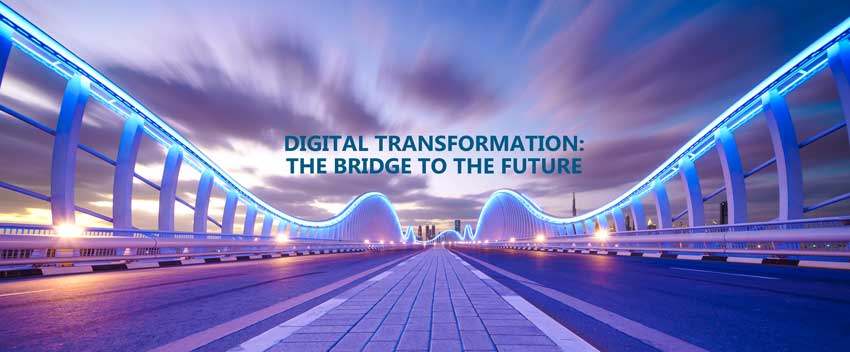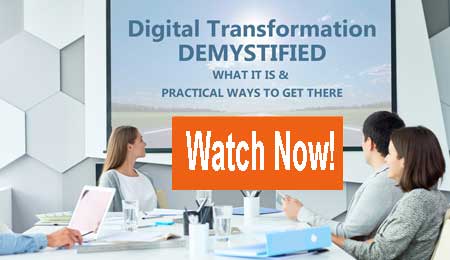
“Digital Transformation” is on the agenda of C-suite executives and technologists in all industries today. It is seen as a bridge to a digital future where organizations can thrive with more fluid business models and processes. The goal is to use data, technology and automation to free people from the need to perform redundant and routine business tasks and allow them to perform activities that provide more connected value to the organization.
Capturing the promise of digital transformation, however, requires more than just technology; it demands a change in mindset. As I explored in my last blog, organizations that continue to regard digital transformation as just a technology bolt on, or something simply for the IT department, will be at risk. Indeed, digital transformation may seem like it’s just about technology, but the transformation that matters most is strategic.
Less than 20% of organizations are getting digital transformation right.
Getting It Right
According to author and futurist, Michael Gale, “less than 20% of organizations are getting digital transformation right.” Michael spoke with me recently on my weekly business podcast, Everyday MBA, about his Wall Street Journal best-selling book, The Digital Helix. While doing research for the book, he and his co-author Chris Aarons came upon some interesting discoveries.
“Digitally transformed organizations can cut their operating expenses by over 30%, and many have seen a near immediate doubling in brand value,” Gale said. “But only a fraction of the companies that we investigated— about 16% — actually got there. And what’s really shocking is that according to our research, 40% of organizations that take on digital transformation have either abandoned or radically slowed down their efforts.”
A Vision of Transformation
With so few organizations getting digital transformation right, what does Gail feel has made the difference for those organizations that have been successful? One factor comes down to C-suite vision and approach.
“There is a tendency for management at the senior level to mandate and then move on. But the capacity to be highly digitally transformed requires that executives roll up their sleeves and truly engage in the process,” said Gale. “They’ve got to be open to experimentation and alternative strategy models. In other words, there isn’t a one-size-fits-all for this.”
Go Slow to Go Fast
A strategic mindset is important in order to embrace the full possibilities of digital transformation, but what specific tactics are used by organizations that capture the real world benefits?
“One of the things we noticed in our research is the idea of going slow to go fast. Organizations that spend time to get people involved, explore alternative strategies and experiment with real purpose reach their goals twice as fast as organizations that get out of the gate quickly, but lack a thoughtful approach,” Gale explained. “We found that amazing things started to happen when organizations slowed down a bit; they were able to jump on new initiatives twice as quickly, and when you measured those initiatives versus others, they got twice the higher returns.”
Capturing the promise of digital transformation, however, requires more than just technology; it demands a change in mindset as well.
“Everybody” Information at USAA
One organization that Gale feels is a good example of an organization taking advantage of digital transformation is banking and insurance provider USAA.
“The insurance industry is a tough business,” Gale said. “It’s really difficult to leave people with a positive, happy feeling because they’re often dealing with difficult things like an insurance claim or a loan. But USAA is extraordinarily sensitive to every single customer’s needs. They feel they have a market of one, not multiple market segments, and they’re extraordinarily good at sharing information about customers from many possible streams of information.”
USAA adopted the idea of sharing information in dashboards, and that has helped the organization transform in ways that have made a difference, according to Gale.
“Everything about a customer’s situation, or who they are, is available to everyone (with clearance) so that when that moment of interaction happens, everyone is empowered to be as successful as possible.” Gale continued, “I think that idea of infinite individualized success is really the essence of how they have been so successful. They took the view that everyone should share all the information available because they never know how, where or why any given customer is going to touch the organization. In this way, information becomes the fundamental DNA of the organization.”
Digital Transformation: Mortgage Processing Automation
The mortgage review process is another example of how digital transformation can have an impact far beyond simply automating labor-intensive, paper handling activities to identify and sort loan-related documents. Mortgage loan packages often involve hundreds of pages of documents. This means longer processing times.
Transforming the processes that involve receiving and processing the paperwork enables greater responsiveness, which can significantly improve the customer experience while also enabling more loans to move through the system. Converting the documents into digital data and automating the identification and sorting of this information are key steps in this digital transformation. Leveraging mortgage processing automation can mean a 20% increase in throughput that leads to tens of millions of dollars in more loans processed each year. With this accelerated capital realization, the financial institution’s portfolio increases, and people get their loans approved faster so it’s a win-win for everyone.
Moving Forward
If you have been considering how digital transformation – and innovations like artificial intelligence, machine learning and advanced analytics – can bring about transformational improvement in the performance of your organization, you can start to move forward by re-envisioning the way that it delivers value to customers. As Gale and Aarons point out in The Digital Helix, organizations are using information to fuel better and faster process performance in important areas like sales, product development, and service and support, but it takes a mindset and commitment that may challenge the status quo.
How can you do it, too? Be willing to go slow to be fast, and look for providers and partners with the right mix of expertise, vision and capability that allow you transition successfully in order to capture the increasing value of digital transformation.
###
Guest contributor Kevin Craine is the author of the book, Designing a Document Strategy and host of AIIM On Air, the podcast for AIIM International. He was named the #1 ECM Influencer to follow on Twitter. Find him at CraineGroup.com.
If you found this article interesting, you might find this webinar on digital transformation useful:
Digital Transformation: What It Is and Practical Ways to Get There

Here is a short video about mortgage document automation:




